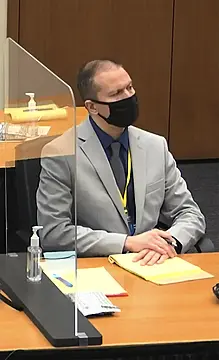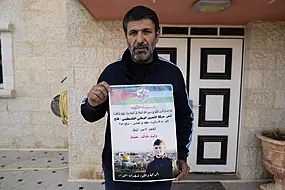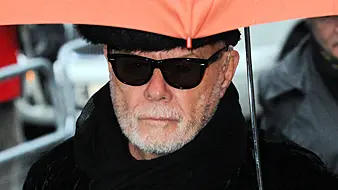A video of George Floyd gasping for breath was front and centre as a former police officer who pressed his knee on the black man’s neck went on trial on charges of murder and manslaughter.
Prosecutor Jerry Blackwell showed jurors the footage at the earliest opportunity, during opening statements, after telling them the number to remember was nine minutes and 29 seconds — the amount of time officer Derek Chauvin had Mr Floyd pinned to the pavement in Minneapolis last May.
The white officer “didn’t let up” even after a handcuffed Mr Floyd said 27 times that he could not breathe and went limp, Mr Blackwell said in a case that triggered worldwide protests, scattered violence and national soul-searching over racial justice.
“He put his knees upon his neck and his back, grinding and crushing him, until the very breath – no, ladies and gentlemen -until the very life was squeezed out of him,” the prosecutor said.
Chauvin lawyer Eric Nelson countered: “Derek Chauvin did exactly what he had been trained to do over his 19-year career.”
Mr Floyd was resisting arrest, and Chauvin arrived to assist other officers who were struggling to get him into a squad car as the crowd around them grew larger and more hostile, Mr Nelson said.
The defence lawyer also disputed that Chauvin was to blame for the death.
Mr Floyd, 46, had none of the telltale signs of asphyxiation and had fentanyl and methamphetamine in his system, Mr Nelson said, adding that Mr Floyd’s drug use combined with his heart disease and high blood pressure, as well as the adrenaline flowing through his body, caused his death from a heart rhythm disturbance.
“There is no political or social cause in this courtroom,” Mr Nelson said. “But the evidence is far greater than nine minutes and 29 seconds.”
A post-mortem noted fentanyl and methamphetamine in Mr Floyd’s system but listed his cause of death as “cardiopulmonary arrest, complicating law enforcement subdual, restraint and neck compression”.

Chauvin, 45, is charged with unintentional second-degree murder, third-degree murder and manslaughter. The most serious charge, the second-degree murder count, carries up to 40 years in prison.
The first witness was Minneapolis police dispatcher Jena Scurry, who said she saw part of Mr Floyd’s arrest unfolding on a city surveillance camera and was so disturbed she called a duty sergeant. Ms Scurry said she became concerned because the officers had not moved after several minutes.
“You can call me a snitch if you want to,” she said in her call to the sergeant, which was played in court. She said she would not normally call about the use of force because it was beyond the scope of her duties, but “my instincts were telling me that something is wrong”.
The video played during opening statements had been posted to Facebook by a bystander who witnessed Mr Floyd being arrested after he was accused of trying to pass a counterfeit 20 dollar bill at a convenience store.
It prompted calls for the country to confront racism and police brutality. Confederate statues and other symbols were pulled down around the US, and activists demanded that police department budgets be cut or overhauled.

Jurors watched intently as the video played on multiple screens, with one drawing a sharp breath as Mr Floyd said he could not breathe. Chauvin sat calmly during opening statements and took notes, looking up at the video periodically.
“My stomach hurts. My neck hurts. Everything hurts,” Mr Floyd says. “I can’t breathe, officer.”
Onlookers repeatedly shout at the officers to get off Mr Floyd, and one woman, identifying herself as a city fire department employee, shouts at Chauvin to check Mr Floyd’s pulse.
Fourteen people in the jury box are hearing the case — eight of them white, six of them black or multiracial, according to the court. Two will be alternatives, though the judge has not said which ones will deliberate the case.
Mr Blackwell said in his opening statement that the fire department first responder who wanted to administer aid was warned off by Chauvin, who pointed Mace at her.
“She wanted to check on his pulse, check on Mr Floyd’s well-being,” Mr Blackwell said. “She did her best to intervene. When she approached Mr Chauvin… Mr Chauvin reached for his Mace and pointed it in her direction. She couldn’t help.”
After the day’s proceedings, a few hundred protesters gathered outside the courthouse. Speakers called for justice for Floyd and others whose lives were lost in encounters with police.







